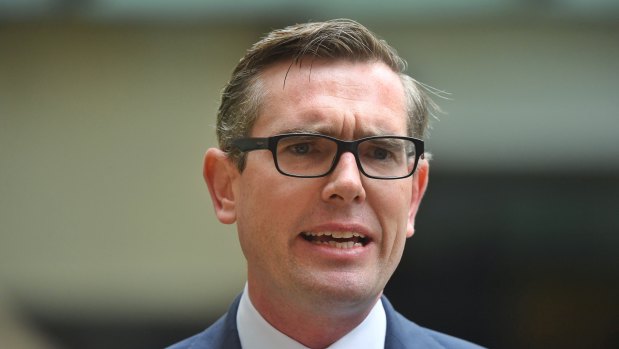This was published 4 years ago
Twin shocks to hit the NSW economy hard
By Matt Wade
Economic growth in NSW could slump to the lowest rate since the recession of the early 1990s as key industries in the state struggle with the effects of the coronavirus outbreak and summer bushfires.
Modelling by NSW treasury shows the combined impact of the bushfires and coronavirus, or COVID-19, will detract between one third of a percentage point and two-thirds of a percentage point from state growth this financial year.

Treasurer Dominic Perrottet says key sectors of the NSW economy are "feeling the pain right now" from the coronavirus crisisCredit: Nick Moir
The latest official forecast, published in December, showed gross state product growth of 1.75 per cent over that period. A detraction of one third of a percentage point – the lower end of treasury’s estimate – will reduce growth to 1.4 per cent, the weakest since the global financial crisis in 2008-09.
But a detraction of two thirds of a percentage point – the higher end of treasury’s estimate – will push NSW growth below 1.1 per cent, the lowest rate since Australia's last recession nearly three decades ago.
Last financial year NSW gross state product grew by 1.9 per cent in 2018-19 to $614 billion.
Should growth rate fall to 1.1 per cent this year the annual output of the economy will be about $4 billion lower than it would have been had growth reached 1.75 per cent as forecast in December.
The slowdown could put the state’s budget surplus in jeopardy as revenue weakens and expenditure rises due to bushfire and drought. Softer economic activity usually pulls down key state revenue sources such as the GST and payroll tax.
A budget surplus of $700 million is predicted for 2019-20, the smallest in seven years, but that forecast was published in December before the bushfires crisis was over and prior to the coronavirus outbreak.
Treasurer Dominic Perrottet said there is “no doubt” the fallout from the coronavirus and bushfires would take a significant economic toll.
"Tourism and education is on the frontline and they are feeling the pain right now - the impact will obviously flow through to retail, trade and investment the longer the situation lasts,” he told the Herald.
“The NSW economy is a fighter, we have taken some heavy punches over the past two years, but we keep stepping back into the ring. We have the lowest unemployment rate in Australia, record investment in public infrastructure, and a “can do” attitude as exemplified during the recent bushfires.”
ANZ economist, Cherelle Murphy, said the structure of the NSW economy meant it was disproportionately exposed to recent economic shocks.
“The NSW economy is front and centre of the COVID-19 and bushfire economic impact as it has such a large share of Australia’s international tourism and student activity," she said.
ANZ has revised down its growth forecast for NSW in 2019-10 to 1.25 per cent from 2 per cent previously. But Ms Murphy warned the risks to that new lower prediction was “definitely to the downside.”
Regional economics expert, Terry Rawnsley, said the inner districts of Sydney and Melbourne were likely to be “hit harder” than many other regions because of the disruption caused to tourism and international education by the coronavirus outbreak.
“The vast bulk of international tourists and international students end up in those two big cities,” he said. “A lot of other imports and exports flow through those global gateways.”
Mr Perrottet has met with university leaders and also charged the state’s chief economist Stephen Walters to liaise with key sectors of the economy to assess the fallout from the two emergencies.
Those twin economic shocks come at a time when momentum in the economy is relatively weak. The ANZ Stateometer, which measures the performance of state economies, showed NSW was “below trend and decelerating” in the December quarter. That result does not include the wort effects of the bushfires and pre-dates coronavirus outbreak.
Fears about the growing economic impact of coronavirus have caused turmoil on global financial markets. The Australian share market plunged almost 10 per cent last week and the Australian dollar fell below US65c for the first time in more than a decade.